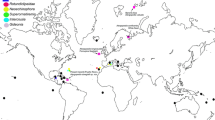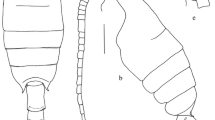Abstract
In contrast to other areas of the planet, very little is known about Antarctic marine invertebrates associated with eutrophic marine benthic areas. Recently, several studies investigated this fauna by experimentally deploying whale bones, leading to the discovery of new opportunistic polychaetes. To investigate the Antarctic organisms associated with these substrates we experimentally deployed whale bones in the shallow waters of Deception Island (South Shetland Islands). We present here the formal description of Parougia diapason sp. nov., a dorvilleid found in remarkable abundance at some of the bones deployed for 1 year. This new Parougia species, the second described in the Southern Ocean, also occurred in moderate numbers at nearby organic-rich sediments close to the Spanish Antarctic Base, indicating that this may be an opportunistic species. P. diapason sp. nov. clearly differs from the rest of congeneric taxa described in the lack of dorsal cirrus as well as in other morphological characters related to the jaw apparatus and the shape of parapodial lobes. Phylogenetic analyses show that P. diapason sp. nov. is sister to the rest of the congeneric taxa whose sequences are currently available. The finding of P. diapason sp. nov. in an area which has been previously investigated using similar experiments suggests that a lot remains to be discovered in Antarctic marine benthic invertebrate communities inhabiting eutrophic habitats.




Similar content being viewed by others
References
Åkesson B, Rice SA (1992) Two new Dorvillea species (Polychaeta, Dorvilleidae) with obligate asexual reproduction. Zool Scr 21:351–362
Bick A (1998) Microphthalmus antarcticus sp. n. (“Polychaeta”, Phyllodocida, Hesionidae) from intertidal coastal areas of King George Island, South Shetlands, Antarctica, with description of the neuropodial setation of further Microphthalmus species. Zool Anz 236:133–138
Bick A, Arlt G (2013) Description of intertidal macro- and meiobenthic assemblages in Maxwell Bay, King George Island, South Shetland Islands, Southern Ocean. Polar Biol 36:673–689
Blake JA, Hilbig B (1990) Polychaeta from the vicinity of deep-sea hydrothermal vents in the Eastern Pacific Ocean. II. New species and records from the Juan de Fuca and Explorer Ridge systems. Pac Sci 44:219–253
Chamberlin RV (1919) The Annelida Polychaeta. Mem Mus Comp Zool Harv 48:1–514
Conlan KE, Kim SL, Lenihan HS, Oliver JS (2004) Benthic changes during 10 years of organic enrichment by McMurdo Station, Antarctica. Mar Pollut Bull 49:43–60
Conlan KE, Kim SL, Thurber AR, Hendrycks E (2010) Benthic changes at McMurdo Station, Antarctica following local sewage treatment and regional iceberg-mediated productivity decline. Mar Pollut Bull 60:419–432
Drummond AJ, Ashton B, Buxton S, Cheung M, Cooper A, Duran C, Field M, Heled J, Kearse M, Markowitz S, Moir R, Stones-Havas S, Sturrock S, Thierer T, Wilson A (2010) Geneious v5.5. http://www.geneious.com
Glover AG, Wiklund H, Taboada S, Avila C, Cristobo J, Smith CR, Kemp KM, Jamieson A, Dahlgren TG (2013) Bone-eating worms from the Antarctic: the contrasting fate of whale and wood remains on the Southern Ocean seafloor. Proc R Soc B Biol Sci 280:1768
Gravier C (1911) Annélides polychètes recueillies par la seconde expédition antarctique française (1908–1910). Deuxième Expédition Antarctique Française 1:1–165, pls 1–12
Hartman O (1953) Non-pelagic polychaeta of the Swedish Antarctic Expedition 1901–1903. Furth Zool Results Swed Antarct Exped 4(11):1–83
Hilbig B, Fiege D (2001) A new species of Dorvilleidae (Annelida: Polychaeta) from a cold seep site in the northeast Pacific. Proc Biol Soc Wash 114:396–402
Jumars PA (1974) A generic revision of the Dorvilleidae (Polychaeta), with six new species from the deep North Pacific. Zool J Linn Soc 54:101–135
Katoh K, Misawa K, Kuma K, Miyata T (2002) MAFFT: a novel method for rapid multiple sequence alignment based on fast Fourier transform. Nucleic Acids Res 30:3059–3066
Lenihan HS, Oliver JS (1995) Anthropogenic and natural disturbances to marine benthic communities in Antarctica. Ecol Appl 5:311–326
McIntosh WC (1885) Report on the Annelida Polychaeta collected by the H.M.S. Challenger during the years 1873–76. Chall Rep 12:1–554
Müller OF (1776) Zoologicae Danicae Prodromus, seu Animalium Daniae et Norvegiae indigenarum characteres, nomina et synonyma imprimis popularium. Hallageriis, Havniae, Copenhagen, pp 282
Orensanz JM (1990) The eunicemorph polychaete anneldis from the Antarctic and Subantarctic Seas. With addenda to the Eunicemorpha of Argentina, Chile, New Zealand, Australia, and the southern Indian Ocean. Biology of the Antarctic Seas XXI. Antarct Res Ser 52:1–183
Oug E (1978) New and lesser known Dorvilleidae (Annelida, Polychaeta) from Scandinavian and northeast American waters. Sarsia 63:285–303
Pearson TH, Rosenberg R (1978) Macrobenthic succession in relation to organic enrichment and pollution of the marine environment. Oceanogr Mar Biol Ann Rev 16:229–311
Posada D (2008) jModelTest: phylogenetic model averaging. Mol Biol Evol 25:1253–1256
Powell S, Palmer A, Johnstone G, Snape I, Stark J, Riddle M (2012) Benthic mats in Antarctica: biophysical coupling of sea-bed hypoxia and sediment communities. Polar Biol 35:107–116
Richardson MD, Hedgpeth JW (1977) Antarctic soft-bottom, macrobenthic community adaptations to a cold, stable, highly productive, glacially affected environment. In: Llano GA (ed) Adaptations within Antarctic ecosystems. Smithsonian Institution, Washington, pp 181–195
Ronquist F, Huelsenbeck JP (2003) MrBayes 3: Bayesian phylogenetic inference under mixed models. Bioinformatics 19:1572–1574
Sicinski J (2000) Polychaeta (Annelida) of Admiralty Bay: species richness, diversity, and abundance. Pol Polar Res 21:153–169
Sicinski J (2004) Polychaetes of Antarctic sublittoral in the proglacial zone (King George Island, South Shetland Islands). Pol Polar Res 25:67–96
Somoza L, Martínez-Frías J, Smellie JL, Rey J, Maestro A (2004) Evidence for hydrothermal venting and sediment volcanism discharged after recent short-lived volcanic eruptions at Deception Island, Bransfield Strait, Antarctica. Mar Geol 203:119–140
Stamatakis A (2006) RAxML-VI-HPC: maximum likelihood-based phylogenetic analyses with thousands of taxa and mixed models. Bioinformatics 22:2688–2690
Stamatakis A, Hoover P, Rougemont J (2008) A fast bootstrapping algorithm for the RAxML web-servers. Syst Biol 57:758–771
Taboada S, Doner S, Blake JA, Avila C (2012) A new species of Cirratulus (Annelida: Polychaeta) described from a shallow-water whale bone in Antarctica. Zootaxa 3340:59–68
Taboada S, Wiklund H, Glover AG, Dahlgren TG, Cristobo J, Avila C (2013) Two new Antarctic Ophryotrocha (Annelida: Dorvilleidae) described from shallow-water whale bones. Polar Biol 36:1031–1045
Thornhill DJ, Struck TH, Ebbe B, Lee RW, Mendoza GF, Levin LA, Halanych KM (2012) Adaptive radiation in extremophilic Dorvilleidae (Annelida): diversification of a single colonizer or multiple independent lineages? Ecol Evol 2:1958–1970
Webster H, Benedict J (1884) The Annelida Chaetopoda from Provincetown and Wellfeet, Mass. Rep US Commnr Fish 1881:699–747
Wolf PS (1986) Three new species of Dorvilleidae (Annelida: Polychaeta) from Puerto Rico and Florida and a new genus for dorvillleids from Scandinavia and North America. Proc Biol Soc Wash 99:627–638
Acknowledgments
Thanks are due to R. de Stephanis, P. Gauffier, J. Giménez and E. Fernández and the institutions EBD-CSIC, CIRCE and Junta de Andalucía, who kindly provided the fresh whale vertebrae for our experiments. We also thank the Gabriel de Castilla Spanish Antarctic Base crew of the 2011–12 and 2012–13 seasons for their help during deployment and recovery of the experiments. We are highly grateful to our ACTIQUIM project colleagues J. Cristobo, A. Riesgo, J. Moles, C. Angulo, B. Figuerola and L. Núñez-Pons, and also to G. Paterson, from the National History Museum of London. Two anonymous reviewers as well as the editor are acknowledged for their comments, which helped to improve a previous version of the manuscript. This research received support from the SYNTHESYS Project (http://www.synthesys.info/), which is financed by the European Community Research Infrastructure Action under the FP7 Integrating Activities Programme, and from the Spanish Government, through the research project ACTIQUIM-II (CTM2010-17415/ANT). This paper is part of the AntEco (State of the Antarctic Ecosystem) Scientific Research Programme.
Author information
Authors and Affiliations
Corresponding author
Electronic supplementary material
Below is the link to the electronic supplementary material.
Rights and permissions
About this article
Cite this article
Taboada, S., Bas, M. & Avila, C. A new Parougia species (Annelida, Dorvilleidae) associated with eutrophic marine habitats in Antarctica. Polar Biol 38, 517–527 (2015). https://doi.org/10.1007/s00300-014-1614-7
Received:
Revised:
Accepted:
Published:
Issue Date:
DOI: https://doi.org/10.1007/s00300-014-1614-7




